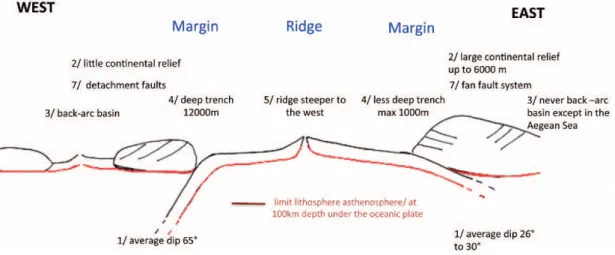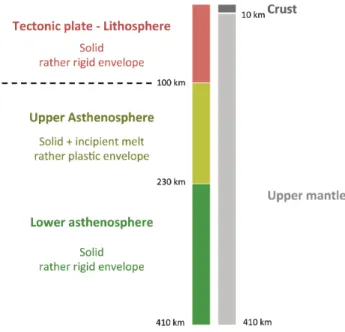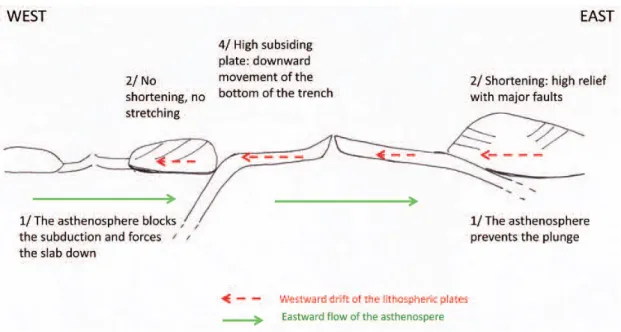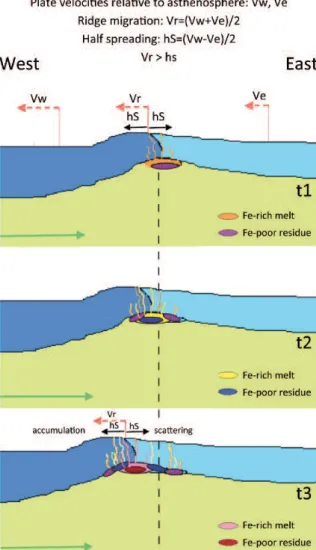HAL Id: hal-02938691
https://hal.univ-lorraine.fr/hal-02938691
Submitted on 15 Sep 2020
HAL is a multi-disciplinary open access
archive for the deposit and dissemination of
sci-entific research documents, whether they are
pub-lished or not. The documents may come from
teaching and research institutions in France or
abroad, or from public or private research centers.
L’archive ouverte pluridisciplinaire HAL, est
destinée au dépôt et à la diffusion de documents
scientifiques de niveau recherche, publiés ou non,
émanant des établissements d’enseignement et de
recherche français ou étrangers, des laboratoires
publics ou privés.
Distributed under a Creative Commons Attribution| 4.0 International License
An alternative model of plate tectonics
Françoise Chalot-Prat, Elisabeth d’Eyrames
To cite this version:
Françoise Chalot-Prat, Elisabeth d’Eyrames. An alternative model of plate tectonics. Proceedings
of the Open University Geological Society, Open University Geological Society, 2018, 4, pp.101-104.
�hal-02938691�
An alternative model of plate tectonics Françoise Chalot-Prat and Elisabeth d’Eyrames
(This article was originally published in €urock The Electronic Newsletter of The Open University Geological Society, Mainland Europe, Winter 2017, 1–5. — Ed.)
Françoise Chalot-Prat, our leader during the mapping week in the Ardèche, has recently been researching lithosphere and asthenosphere interactions at ocean ridges in the framework of the westward drift of plates, in collaboration with C. Doglioni (Italia) and T. Falloon (Australia).
They combine geophysical, structural and petrological data to support an alternative model for oceanic plate spreading. The results of their research have been published in Lithos (Chalot-Prat et al. 2017). A synthetic slide presentation, including figures from previous papers, is available on the website mantleplumes.org). This fairly new model of the ‘westward drift’ as a driving force of plates intrigued us all, and eventually we got Françoise to give us a presentation on the last afternoon of our mapping week. So we all gathered at the bar, where Françoise gave us an off-the-cuff presentation about this research. Here is the transcription of it:
Following Alfred Wegener’s (1915) continental drift, the theory of plate tectonics was introduced in 1968 to the scientific community and was accepted three years later. The theory was based on tectonic lithospheric plates composed of crust and uppermost mantle, moving over or descending into the asthenosphere or deeper.
W. J. Morgan (1971, 1972) published the following idea: mantle convection is moving the plates and transfers matter within the mantle and, accordingly, the model of mantle plumes. It was only an idea without any observations supporting it.
The hitch is that convection cells are symmetric and symmetry is not observed in plate tectonics. The first to observe asymmetry was Carlo Doglioni when he was working on geophysical data around the world. His first paper was published in 1990 (The global tectonic pattern). As the model of convection cells does not support asymmetry, he also presented another model for plate tectonics (Doglioni 1993; Doglioni et al. 1999, 2003, 2007).
For example, when observing a cross section through oceans framed by subduction zones like the
Pacific Ocean a number of asymmetries can be listed (Fig. 1).
Figure 1 List of asymmetries that can be observed on a cross section through oceans framed by subduction zones similar to the Pacific Ocean.
1. The dip of the slope of the oceanic slab subducting westward is on average of 65° and eastward only 30° on average. These observations also concern subducting continental slabs in collision zones (for example, in the Alps and in the Apennines).
2. On the western margin, there is little continental relief, whereas on the eastern margin there is a large continental relief that can reach 6000m in altitude.
3. Back-arc basins form west to a western margin, which is rarely the case east to an eastern margin (the Aegean Sea is an exception).
4. The subduction trench is far deeper in the west (up to 12,000m) than in the east, where it reaches
5. The slope of the western side of an ocean ridge is always steeper than on its eastern side.
6. The fault system within the orogen on each side of the ocean is different. On the western margin, the orogen is mainly crosscut by major west-dipping faults (simple vergence system), whereas the orogen on the eastern margin is crosscut by a double vergence system (east-dipping faults to the west and west-dipping faults to the west).
The cause of plate tectonics cannot be one that produces symmetrical features like convection.
Therefore Doglioni proposes another explanation: “The movement of the plates is due to the rotation of the Earth counteracted by the rotation of the Moon.” (Doglioni 1990, 1993; Scoppola et al. 2006). The rheology of the lithosphere differs from the uppermost part (100–230km) of the asthenosphere (Fig. 2); the lithosphere is solid and rather rigid, whereas the uppermost part of the asthenosphere has a plastic behaviour because it is a solid with incipient melt, as we know from geophysics and experimental lab research.
Figure 2 Rheology and thickness of the lithosphere and the asthenosphere below oceans.
The bulk of the Earth (mantle) rotates eastward (Fig. 3A). The lithosphere, which is more rigid (or
viscous), rotates at a slower speed and thus lags behind. To help to grasp this model and reason with it, Doglioni (1993) proposed the concept of ‘westward drift of the lithosphere’; instead of speaking about the lithosphere lagging behind the mantle, he considers the relative movement of the lithosphere to the asthenosphere, which is a drift to the west. Besides, the lithosphere is heterogeneous, so that its whole rigidity varies significantly from place to place. The different parts have thus different velocities and the lithosphere fragments into different plates. When the western part of a plate drifts faster towards the west than the eastern part, spreading occurs. If the western part of a plate drifts more slowly to the west than the eastern part, subduction occurs (Fig. 3B). The more a plate is rigid, the more it lags and the faster it drifts to the west.
Figure 3 A, Definition of the ‘westward drift’ model on a cross section of the Earth at the equator, view from the North Pole; B, spreading and subduction in the westward drift model.
Now, how can previous asymmetries observed across an ocean bordered by subduction zones be explained with this concept?
On Figure 4, the western subduction zone can now be read as a slow drifting plate (margin) followed
eastward by a quicker drifting plate (subducting slab). The asthenospheric flow pushes the slab downward and conversely, on the eastern side of the ocean, the asthenospheric flow prevents the plunge of the slab. The high velocity of the sub-vertical westward-subsiding oceanic plate, always higher than the sedimentation velocity, explains the deep western trench and the great thickness of accumulated sediments. The high relief on the eastern margin is explained by the intense shortening of the continental lithosphere as it is blocked by the slower oceanic plate that plunges beneath it.
In continental settings, when the western continental plate drifts slower than the eastern continental plate, similar asymmetrical features are observed: deep trenches, steep subducted slab and moderate margin are observed.
Figure 4 The asymmetries observed in the context of the westward drift of the lithospheric plates.
In return, high margin relief and subducted slab with low slope are observed in east-dipping subduction contexts. This process is illustrated by the following examples. In Romania, south-east of the
Carpathian Mountains (risingup to 2,600m), the Focsani Basin is the result of the north-west subduction of a continental plate below the Carpathian plate. This subduction started 10Ma ago and accumulated 8,000m of sediments that produced oil and gas. In Italy, the Apennines (rising up to 2,900m) are a collision zone, where the faster-drifting north-east plate subducts under the south-west plate with a dip of 80°. In the Alps, the European plate plunges south-eastward at an angle of 30° below the Adriatic plate, with many summits above 4,000m (rising up to 4,800m).
In addition to these observations of asymmetrical structures, geophysics show that the oceanic eastern plate has less thickness, lower density and less rigidity than the western plate. It can be explained by significantly different growth conditions of the western and eastern plates, inducing sensibly distinct mantle thickness and composition from one plate to the other on each side of the ridge axis.
When considering what happens during ocean spreading within the westward drift model, the scenario
Figure 5 How to build asymmetric plates on both sides of a spreading ridge? Oceanic spreading is synchronous with westward drift of lithosphere above asthenosphere. The half spreading rate hS on both sides of the ridge is lower than the ridge velocity Vr. Starting with t1 being the initial situation, t2 and t3 show how in time each limb on each side of the ridge axis acquires mantle thickness, composition and morphology sensibly different from the other.
(a) At the spreading axis (Fig.5 t1), the asthenosphere ascends and undergoes partial melting, leading to formation of a basaltic magma and a Fe-depleted residual mantle. The residue, less dense than its protolith, accretes to the base of the overlying lithospheric mantle (minimum of 30km in thickness at
the ridge axis), while the pressurised magma percolates upward either very quickly to give basaltic
volcanoes on the ocean bottom, or slowly in between mantle minerals with which it reacts
(metasomatism and mantle refertilisation). So one way or another during spreading, the lithospheric mantle thickens. This leads to the following questions: Why is there less thickening eastward of the ridge axis? And why are mantle compositions slightly different in the western and eastern plates? (b) As the spreading ridge migrates with the westward drift, the asthenospheric partial melting zone below the ridge migrates with the westward drift too. The effects are necessarily different on either side of the ridge axis. Indeed the ridge migration velocity (Vr) is always higher than the half-spreading velocity (hS) (see equations on Fig. 5). This means that the eastern limb of the ridge axis is progressively abandoned eastward, whereas the western limb of ridge axis stays above the melting zone for a while, depending on the spreading rate. At t2, then t3 (Fig. 5), residues progressively accumulate against and partly on each other at the base of the western limb, whereas residues are scattered at the base of the eastern limb.
(c) The western limb thickens faster and more significantly than the eastern limb. In doing so, the western mantle plate is strongly Fe-re-enriched and refertilised by metasomatism. It becomes denser and more rigid (Fe has the highest modulus of rigidity) than the eastern plate.
(d) The eastern limb is much less metasomatised and refertilised. It is less dense than the western one, and the isostatic compensation induces a higher uplift of the eastern limb and a slope asymmetry of both sides of the ridge.
These are, schematically, the basic features of the alternative model for understanding the growth of an ocean. There were many questions about this alternative model of plate tectonics, so that for further reading Françoise forwarded us a list of papers supporting the observations on asymmetry of the Earth.
References
Chalot-Prat, F., Doglioni, C., and Falloon T. 2017 ‘Westward migration of oceanic ridges and related asymmetric upper mantle differentiation’. Lithos 268–271, 163–73
Chalot-Prat, F., Doglioni, C., and Falloon T. 2017 ‘Westward migration of oceanic ridges and asymmetric upper mantle differentiation’ Slide presentation on
http://www.mantleplumes.org/Asymmetry_Chalot-Prat.pdf
Doglioni, C. 1990 ‘The global tectonic pattern'. J Geodynamics 12, 1, 21–38
Doglioni, C. 1993 ‘Geological evidence for a global tectonic polarity'. J Geol Soc 150, 991–1002
Doglioni, C., Harabaglia, P., Merlini, S., Mongelli, F., Peccerillo, A., and Piromallo, C. 1999 ‘Orogens and slabs vs their direction of subduction’. Earth-Science Rev 45, 167–208
Doglioni, C., Carminati, E., and Bonatti, E. 2003 ‘Rift asymmetry and continental uplift’. Tectonics 22, 1024–37; doi:10.1029/2002TC001459
Doglioni, C., Carminati, E., Cuffaro, M., and Scrocca, D. 2007 ‘Subduction kinematics and dynamic constraints’. Earth Science Rev 83, 125–75; doi:10.1016/j.earscirev.2007.04.001
Morgan, W. J. 1971 ‘Convection Plumes in the Lower Mantle'. Nature 230, 42–3
Morgan, W. J. 1972 ‘Plate motions and deep mantle convection'. Amer Assoc Petroleum Geol Bull 56, 203–13; doi 10.1306/819A3E50-16C5-11D7-8645000102C1865D
Scoppola, B., Boccaletti, D., Bevis, M., Carminati, E., and Doglioni, C. 2006 ‘The westward drift of the lithosphere: a rotational drag?’. Geol Soc Amer Bull 118, 199–209; doi:10.1029/2004TC001634 Wegener, A. 1915 ‘Die Entstehung der Kontinente und der Ozeane’. Samml. Vieweg, Braunschweig 23, 1–94
[figure captions]
Figure 1 List of asymmetries that can be observed on a cross section through oceans framed by subduction zones similar to the Pacific Ocean.
Figure 2 Rheology and thickness of the lithosphere and the asthenosphere below oceans.
Figure 3 A, Definition of the ‘westward drift’ model on a cross section of the Earth at the equator, view from the North Pole; B, spreading and subduction in the westward drift model.
Figure 4 The asymmetries observed in the context of the westward drift of the lithospheric plates. Figure 5 How to build asymmetric plates on both sides of a spreading ridge? Oceanic spreading is synchronous with westward drift of lithosphere above asthenosphere. The half spreading rate hS on both sides of the ridge is lower than the ridge velocity Vr. Starting with t1 being the initial situation, t2 and t3 show how in time each limb on each side of the ridge axis acquires mantle thickness,



